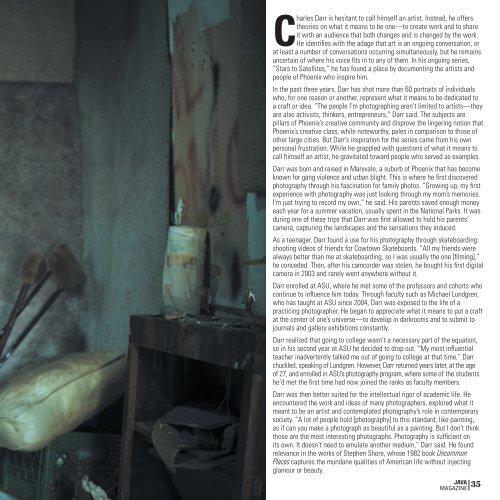Java.FEB.2017
Create successful ePaper yourself
Turn your PDF publications into a flip-book with our unique Google optimized e-Paper software.
Charles Darr is hesitant to call himself an artist. Instead, he offers<br />
theories on what it means to be one—to create work and to share<br />
it with an audience that both changes and is changed by the work.<br />
He identifies with the adage that art is an ongoing conversation, or<br />
at least a number of conversations occurring simultaneously, but he remains<br />
uncertain of where his voice fits in to any of them. In his ongoing series,<br />
“Stars to Satellites,” he has found a place by documenting the artists and<br />
people of Phoenix who inspire him.<br />
In the past three years, Darr has shot more than 60 portraits of individuals<br />
who, for one reason or another, represent what it means to be dedicated to<br />
a craft or idea. “The people I’m photographing aren’t limited to artists—they<br />
are also activists, thinkers, entrepreneurs,” Darr said. The subjects are<br />
pillars of Phoenix’s creative community and disprove the lingering notion that<br />
Phoenix’s creative class, while noteworthy, pales in comparison to those of<br />
other large cities. But Darr’s inspiration for the series came from his own<br />
personal frustration. While he grappled with questions of what it means to<br />
call himself an artist, he gravitated toward people who served as examples.<br />
Darr was born and raised in Maryvale, a suburb of Phoenix that has become<br />
known for gang violence and urban blight. This is where he first discovered<br />
photography through his fascination for family photos. “Growing up, my first<br />
experience with photography was just looking through my mom’s memories.<br />
I’m just trying to record my own,” he said. His parents saved enough money<br />
each year for a summer vacation, usually spent in the National Parks. It was<br />
during one of these trips that Darr was first allowed to hold his parents’<br />
camera, capturing the landscapes and the sensations they induced.<br />
As a teenager, Darr found a use for his photography through skateboarding:<br />
shooting videos of friends for Cowtown Skateboards. “All my friends were<br />
always better than me at skateboarding, so I was usually the one [filming],”<br />
he conceded. Then, after his camcorder was stolen, he bought his first digital<br />
camera in 2003 and rarely went anywhere without it.<br />
Darr enrolled at ASU, where he met some of the professors and cohorts who<br />
continue to influence him today. Through faculty such as Michael Lundgren,<br />
who has taught at ASU since 2004, Darr was exposed to the life of a<br />
practicing photographer. He began to appreciate what it means to put a craft<br />
at the center of one’s universe—to develop in darkrooms and to submit to<br />
journals and gallery exhibitions constantly.<br />
Darr realized that going to college wasn’t a necessary part of the equation,<br />
so in his second year at ASU he decided to drop out. “My most influential<br />
teacher inadvertently talked me out of going to college at that time,” Darr<br />
chuckled, speaking of Lundgren. However, Darr returned years later, at the age<br />
of 27, and enrolled in ASU’s photography program, where some of the students<br />
he’d met the first time had now joined the ranks as faculty members.<br />
Darr was then better suited for the intellectual rigor of academic life. He<br />
encountered the work and ideas of many photographers, explored what it<br />
meant to be an artist and contemplated photography’s role in contemporary<br />
society. “A lot of people hold [photography] to this standard, like painting,<br />
as if can you make a photograph as beautiful as a painting. But I don’t think<br />
those are the most interesting photographs. Photography is sufficient on<br />
its own. It doesn’t need to emulate another medium,” Darr said. He found<br />
relevance in the works of Stephen Shore, whose 1982 book Uncommon<br />
Places captures the mundane qualities of American life without injecting<br />
glamour or beauty.<br />
JAVA 35<br />
MAGAZINE


















